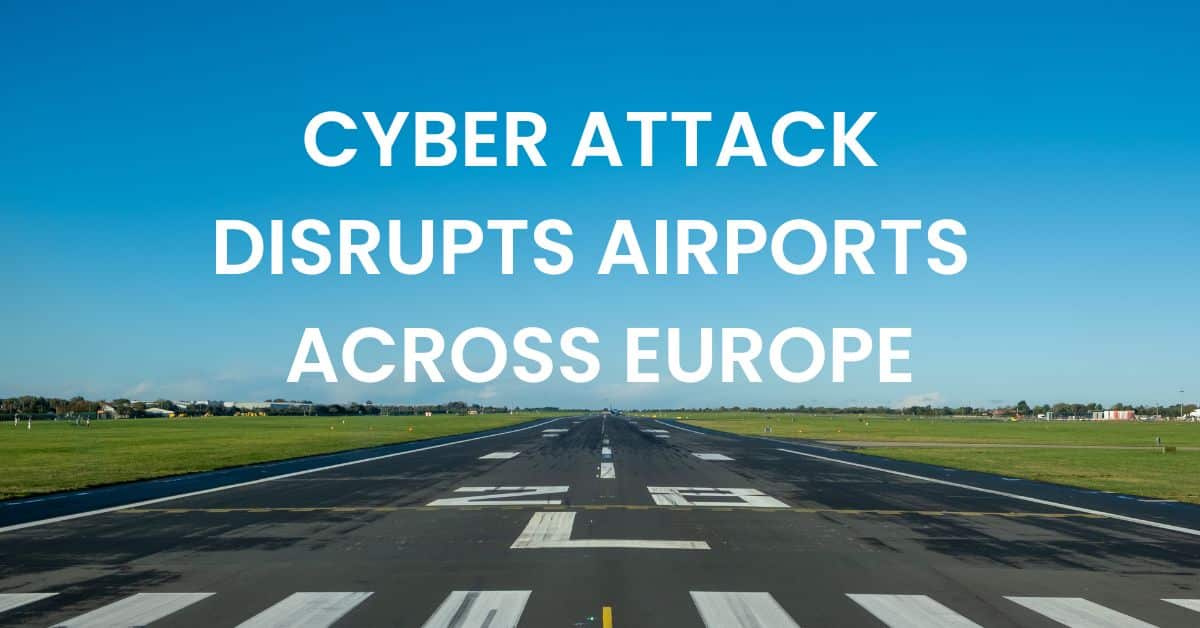When Heathrow, Brussels, and Berlin airports suffered a cyber attack that disrupted their check-in and baggage systems, the fallout was immediate. Flights were canceled, queues stretched through terminals, and staff scrambled to switch to manual processes. For some of Europe’s busiest hubs, this was more than an inconvenience. It was a reminder that disruption, not data theft, is often the attacker’s goal.
What Happened During The Cyberattack Affecting European Airports?
According to multiple outlets, the cyberattack targeted Collins Aerospace’s MUSE/cMUSE passenger processing platform, a shared system used by many airlines for check-in, bag drop, and boarding.
With the platform offline, airports switched to manual check-in and boarding. This kept passengers moving, but slowly. Brussels reported the highest number of early cancellations, while Heathrow and Berlin saw significant queues and delays. Flight safety systems, including air traffic control and avionics, were not affected. Investigators have not named a perpetrator, and attribution speculation is premature.
Ross Brewer, VP & Managing Director, EMEA, explained in his BBC interview: “This wasn’t about data theft. It was about disruption at scale and it shows how attackers are evolving their tactics.”
Why Is Disruption as Dangerous as Data Theft?
Security leaders often think in terms of breaches and stolen records. But as Ross Brewer pointed out, disruption can be just as damaging: “This is about resilience. Organizations need to detect and respond in minutes, not hours, if they want to avoid making the news for all the wrong reasons.”
The Heathrow incident reinforces three realities for security teams:
- Disruption is the attack. Lost productivity, missed slots, and stranded travelers can cost as much as stolen data.
- Alert fatigue delays response. If analysts need multiple tools and hours to piece together context, attackers gain the upper hand.
- Preparedness is non-negotiable. Organizations dependent on shared systems must expect disruption attempts and plan faster responses.
This year has shown the same pattern across critical UK sectors:
- Retail: Marks & Spencer endured weeks-long disruption, followed by a CTO departure.
- Manufacturing: Jaguar Land Rover halted global production in September after a cyber incident.
- Utilities: More than half of UK and US water and power providers reported disruptive attacks, including Southern Water’s breach attributed to Black Basta.
The theme is clear: identity compromise and third-party dependencies create high-blast-radius outages, even when safety-critical systems remain untouched.
How Can Organizations Respond More Effectively?
This attack highlights the need for a platform that delivers speed, context, and precision. That is where Graylog comes in.
- Context-aware incident Response gives analysts the full picture on one screen, cutting mean time to triage from 20 minutes to about 2.
- Entity-Centric Risk Modeling collapses thousands of alerts into a handful of high-risk entities, reducing noise and sharpening focus.
- Threat Intelligence Integration flags malicious IPs, domains, and file hashes automatically, providing actionable context from the start.
But detection is only half the battle. Many security operations teams underestimate how critical search is during investigations. When every second counts, analysts cannot afford to wait minutes or hours for queries to return results. They need the ability to pivot instantly across massive volumes of disparate log data to confirm indicators, validate activity, and find the real threat.
Graylog’s search is designed for speed and precision at scale. Analysts can query across billions of events in seconds without complex query languages or schema limitations. This matters because in a disruption scenario, the faster you confirm scope and impact, the faster you can restore operations. Competitors often struggle here, leaving teams blind at the exact moment they need clarity.
For airports, hospitals, utilities, and other critical sectors, the ability to move from alert to investigation to response in minutes is the difference between inconvenience and crisis.
What Should Security Leaders Ask Themselves Now?
If attackers disrupted your core systems today:
- How quickly could your team detect and respond?
- Could you prevent hours of downtime?
- Can your analysts pivot across all relevant data in seconds, or would they still be waiting for query results as the disruption spreads?
With Graylog Security, teams move faster, reduce alert fatigue, and close investigations with the clarity that only rapid search provides. It is SIEM Without Compromise, because resilience depends on it.



